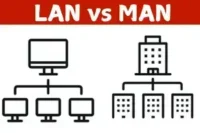What are the Advantages and Disadvantages of Storage Area Network(SAN)?
Published: January 14, 2025
Storage Area Networks (SANs) are the backbone of modern business storage systems, providing centralized, high-speed access to massive data. According to industry reports, SAN solutions can improve data transfer rates by up to 40%, making them a favorite among businesses handling critical workloads. However, like any technology, SANs have their share of advantages and disadvantages that organizations must consider before implementation.

A Storage Area Network (SAN) is a special network that connects computers to storage devices, like big hard drives. It helps share data quickly and safely, making it useful for storing important information.
Advantages and Disadvantages of Storage Area Network
The Storage Area Network (SAN) offers some great benefits but has challenges, so it’s important to carefully think about both before deciding.
Advantages of Storage Area Network (SAN)
With a Storage Area Network (SAN), businesses can enjoy better communication and quicker data access on a global scale.

Here are the key benefits of a Storage Area Network (SAN):
- Control storage from one place
- Better protection of data
- Save space, store more
- Faster data transfer
- Easier data backup
- Better resource utilization
- Share data easily
- Saves money over time
Let’s dive into how this can simplify things for us.
1. Control Storage from One Place
A SAN allows you to manage all your storage devices from a single location, making monitoring and controlling how data is stored and accessed across the network easier.
2. Better Protection of Data
With a SAN, your data is more secure because it uses advanced security features like encryption and access controls, ensuring that only authorized users can access important information.
3. Save Space, Store More
SANs are designed to be space-efficient. By centralizing storage, businesses can store large amounts of data in a smaller physical area, reducing the need for multiple storage devices.
4. Faster Data Transfer
SANs offer high-speed data transfer between storage devices and servers. It means data can be accessed and moved quickly, improving business applications’ overall performance.
5. Easier Data Backup
Since all data is stored centrally in a SAN, performing backups becomes much simpler. You can back up all the data from one location instead of managing backups for different devices.
6. Better Resource Utilization
SANs help you use your hardware better. By combining resources, your servers and storage devices work more efficiently, which reduces waste and improves performance.
7. Share Data Easily
With a SAN, multiple servers can access the same data without issues. It makes sharing information between different systems quick and easy, improving collaboration within the organization.
8. Saves Money Over Time
While the initial setup of a SAN might be costly, it saves money in the long run by reducing hardware costs, minimizing downtime, and improving data management and backup efficiency.
Disadvantages of Storage Area Network
Understanding these possible issues is crucial before fully depending on a Storage Area Network (SAN) for your business.

These are the key drawbacks of a Storage Area Network (SAN):
- Expensive to set up
- Needs experts to manage
- Risks of hacking
- Hard to expand
- If one fails, all fail
- Compatibility issues
- Slows down sometimes
- Needs special equipment
Let’s dive into the disadvantages of Storage Area Networks and see how they might impact your setup.
1. Expensive to Set Up
Setting up a SAN can be costly because it requires special hardware, software, and installation services.
2. Needs Experts to Manage
SANs need skilled professionals to manage them, as the system requires technical knowledge and experience to keep it running smoothly.
3. Risks of Hacking
Since SANs store a lot of important data, they can be targets for hackers. If not properly secured, unauthorized people could access sensitive information.
4. Hard to Expand
Expanding a SAN can be tricky, especially if the system wasn’t initially designed to grow. Adding new devices or resources might require complex adjustments.
5. If One Fails, All Fail
In some SAN setups, if one part of the system fails, it can cause the entire network to stop working, leading to downtime and potential data loss.
6. Compatibility Issues
SANs may not always work well with existing systems or devices, leading to compatibility issues that can make integration difficult.
7. Slows Down Sometimes
Sometimes, a SAN might experience performance issues, causing it to slow down when handling large amounts of data or heavy traffic.
8. Needs Special Equipment
SANs require specialized equipment like dedicated servers, storage devices, and network components, which can be expensive and require regular maintenance.
Conclusion
In this article, we’ve comprehensively explored the Advantages and Disadvantages of Storage Area Networks. If you’re considering adopting SAN for your organization, it’s important to consider both the speed and security benefits, along with potential setup challenges. Evaluate your current infrastructure and team expertise before making any decisions. If you’re ready, dive deeper into the world of SAN to see if it’s the right fit for your network setup!
FAQs About Advantages and Disadvantages of Storage Area Network
A Storage Area Network (SAN) is a system that links storage devices and servers, helping businesses manage data more efficiently. It speeds up data transfer and makes storage more secure. It’s a great solution for companies that handle a lot of data.
SANs offer faster data transfers, centralize data management, and provide better security. They’re perfect for businesses that need to improve their network performance and scale as they grow. With a SAN, accessing large amounts of data becomes much simpler and quicker.
While SANs are powerful, they can be pricey to set up and manage. You’ll also need skilled professionals to keep everything running smoothly. Additionally, they may have compatibility issues and might not be the best fit for small businesses.
A Storage Area Network (SAN) stores and accesses data quickly. A Campus Area Network (CAN) connects different buildings on campus to share resources and communicate.
SANs improve data transfer by offering high-speed connections between storage devices and servers. It reduces delays and boosts data flow, making it ideal for businesses that need quick access to large files. It ensures smooth operations without lag.
Yes, expanding a SAN is relatively easy as your data needs grow. You can add more storage devices or servers to the network, allowing it to scale without affecting your existing system. This flexibility makes SANs great for businesses looking to grow.
Yes, SANs are very secure, offering features like encryption and firewalls to protect your data. But just like any network, they must be properly managed to stay safe. Regular security checks and access control are key to keeping your data secure.
SANs are best for businesses that handle a lot of data and need fast, reliable access. Industries like healthcare, finance, and media companies benefit from using SANs. While they might be too costly for small businesses initially, they’re ideal as your company grows.
A regular network connects devices to share data, while a SAN is about storage. It connects storage devices and servers to create a high-speed network dedicated solely to storing and retrieving data. It makes SANs more efficient for large-scale storage needs.
Setting up a SAN can be costly, especially with specialized hardware and software. There are also ongoing costs for maintenance and expert management. But for bigger businesses, the cost is worth it for the improved speed and reliability.
Absolutely! SANs are perfect for backing up large amounts of data quickly. Their fast transfer speeds and centralized storage management make data recovery easy and efficient, helping businesses ensure they can restore their data when needed.
Network security systems should be updated regularly. Ideally, every time security patches or updates are released. Critical updates should be installed immediately to protect against newly discovered vulnerabilities.
A Storage Area Network (SAN) uses the TCP/IP model’s five layers to ensure efficient data transmission, from physical connections (Physical and Data Link layers) to reliable data transfer (Transport layer) and application-level access. The Network layer handles routing between SAN devices across large distances.
A backbone cable enhances SAN performance by facilitating fast data transfer between servers and storage devices, ensuring quick access to data.





